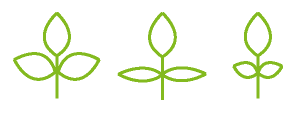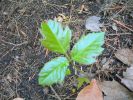Identification Principle 4 : Poison Ivy May Have a Reddish Leaf Junction
|
We're starting to get onto the sketchy identification principles now. Poison ivy generally has a reddish or brownish or darker junction where the three leaves come together, or anywhere there is a junction in the stem. However, it doesn't always appear, and this reddish/discolored junction also happens in some other plants. |
Identification Principle 5 : Poison Ivy Generally Has Similar-Sizes Leaves
|
Some plants consistently have a bigger terminal leaf than the paired leaves further back on the stem, or vice-versa. Poison ivy, however, generally has similar-sized leaves in the same cluster. Only in rare cases does poison ivy have leaves of radically different size in the same cluster. | ||||
Identification Principle 6 : Poison Ivy May Appear Glossy
|
Poison ivy sometimes has a glossy sheen to it's leaves, particularly when the plant is young. However, it isn't always like that at all. I'd say that the average poison ivy leaf is 'shinier' than the average non-poison-ivy leaf, but clearly this isn't a great identification principle. |
Finally, a few words on indirect identification of poison ivy. Poison ivy is a disturbed area plant, generally found in urban areas, gardens, yards, roadsides, trails, etc. It is exceedingly rare to find poison ivy a ways into any backcountry area, unless there are heavily traveled trails. The plant tends to enjoy its sun and water. It is more likely to thrive on trailsides and roadsides, where there is plenty of light, than deeper in the woods. Poison ivy also grows well along stream and riverbanks. Anecdotally, I find that well watered areas such as these, or urban areas which are regularly irrigated, have the biggest-leaved poison ivy.
Winter identification is tricky (the leaves aren't the only parts of the plant with toxic oils), because leaves are the way we pick poison ivy out. For some folks, it's still worth thinking about. If you are in the habit of traipsing around the woods in the leafless seasons, consider taking a few moments to check out what the branches and vines of poison ivy look like when the leaves are still there to provide you ID. Then you'll have a rough idea of what to avoid in the fall and winter, though it isn't nearly as straightforward a process.
Ok. You have the principles. Now go check out the pictures so you can see what it actually looks like.
| And again-- I'm back in school. Deep in the red. I made this page years ago and now it is getting hundreds of visitors a month. If even a tiny fraction of those folks gave me a little change it would pay the hosting fees. Please consider donating a dollar or two via Paypal- anything over 30 cents as that is the fee Paypal takes out per donation. They take credit cards, its secure, and all that good stuff. Thanks! |


